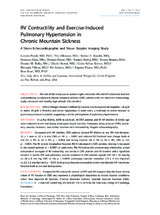Mostrar el registro sencillo del ítem
RV contractility and exercise-induced pulmonary hypertension in chronic mountain sickness : a stress echocardiographic and tissue doppler imaging study
| dc.contributor.author | Pratali, Lorenza | |
| dc.contributor.author | Allemann, Yves | |
| dc.contributor.author | Rimoldi, Stefano F | |
| dc.contributor.author | Faita, Francesco | |
| dc.contributor.author | Hutter, Damian | |
| dc.contributor.author | Rexhaj, Emrush | |
| dc.contributor.author | Brenner, Roman | |
| dc.contributor.author | Bailey, Damian M | |
| dc.contributor.author | Sartori, Claudio | |
| dc.contributor.author | Salinas Salmón, Carlos E | |
| dc.contributor.author | Villena, Mercedes | |
| dc.contributor.author | Scherrer, Urs | |
| dc.contributor.author | Picano, Eugenio | |
| dc.contributor.author | Sicari, Rosa | |
| dc.date.accessioned | 2016-09-26T14:43:50Z | |
| dc.date.available | 2016-09-26T14:43:50Z | |
| dc.date.issued | 2013-12 | |
| dc.identifier.uri | http://repositorio.umsa.bo/xmlui/handle/123456789/8024 | |
| dc.description.abstract | Objectives. The aim of this study was to evaluate right ventricular (RV) and left ventricular function and pulmonary circulation in chronic mountain sickness (CMS) patients with rest and stress echocardiography compared with healthy high-altitude (HA) dwellers. BAC KG ROU N D CMS or Monge’s disease is defined by excessive erythrocytosis (hemoglobin >21 g/dl in males, 19 g/dl in females) and severe hypoxemia. In some cases, a moderate or severe increase in pulmonary pressure is present, suggesting a similar pathogenesis of pulmonary hypertension. M E T H O D S In La Paz (Bolivia, 3,600 m sea level), 46 CMS patients and 40 HA dwellers of similar age were evaluated at rest and during semisupine bicycle exercise. Pulmonary artery pressure (PAP), pulmonary vascular resistance, and cardiac function were estimated by Doppler echocardiography. R E S U LT S Compared with HA dwellers, CMS patients showed RV dilation at rest (RV mid diameter: 36 5 mm vs. 32 4 mm, CMS vs. HA, p ¼ 0.001) and reduced RV fractional area change both at rest (35 9% vs. 43 9%, p ¼ 0.002) and during exercise (36 9% vs. 43 8%, CMS vs. HA, p ¼ 0.005). The RV systolic longitudinal function (RV-S0) decreased in CMS patients, whereas it increased in the control patients (p < 0.0001) at peak stress. The RV end-systolic pressure-area relationship, a load independent surrogate of RV contractility, was similar in CMS patients and HA dwellers with a significant increase in systolic PAP and pulmonary vascular resistance in CMS patients (systolic PAP: 50 12 mm Hg vs. 38 8 mm Hg, CMS vs. HA, p < 0.0001; pulmonary vascular resistance: 2.9 1 mm Hg/min/l vs. 2.2 1 mm Hg/min/l, p ¼ 0.03). Both groups showed comparable systolic and diastolic left ventricular function both at rest and during stress. CO N CLU S I O N S Comparable RV contractile reserve in CMS and HA suggests that the lower resting values of RV function in CMS may represent a physiological adaptation to chronic hypoxic conditions rather than impaired RV function. (Chronic Mountain Sickness, Systemic Vascular Function [CMS]; NCT01182792) | es_ES |
| dc.language.iso | en | es_ES |
| dc.publisher | ELSEVIER | es_ES |
| dc.subject | HIPERTENSIÓN PULMONAR | es_ES |
| dc.subject | MAL CRÓNICO DE MONTAÑA | es_ES |
| dc.subject | ESTRÉS ECOCARDIOGRÁFICO | es_ES |
| dc.subject | DOPPLER TISULAR | |
| dc.title | RV contractility and exercise-induced pulmonary hypertension in chronic mountain sickness : a stress echocardiographic and tissue doppler imaging study | es_ES |
| dc.type | Article | es_ES |

